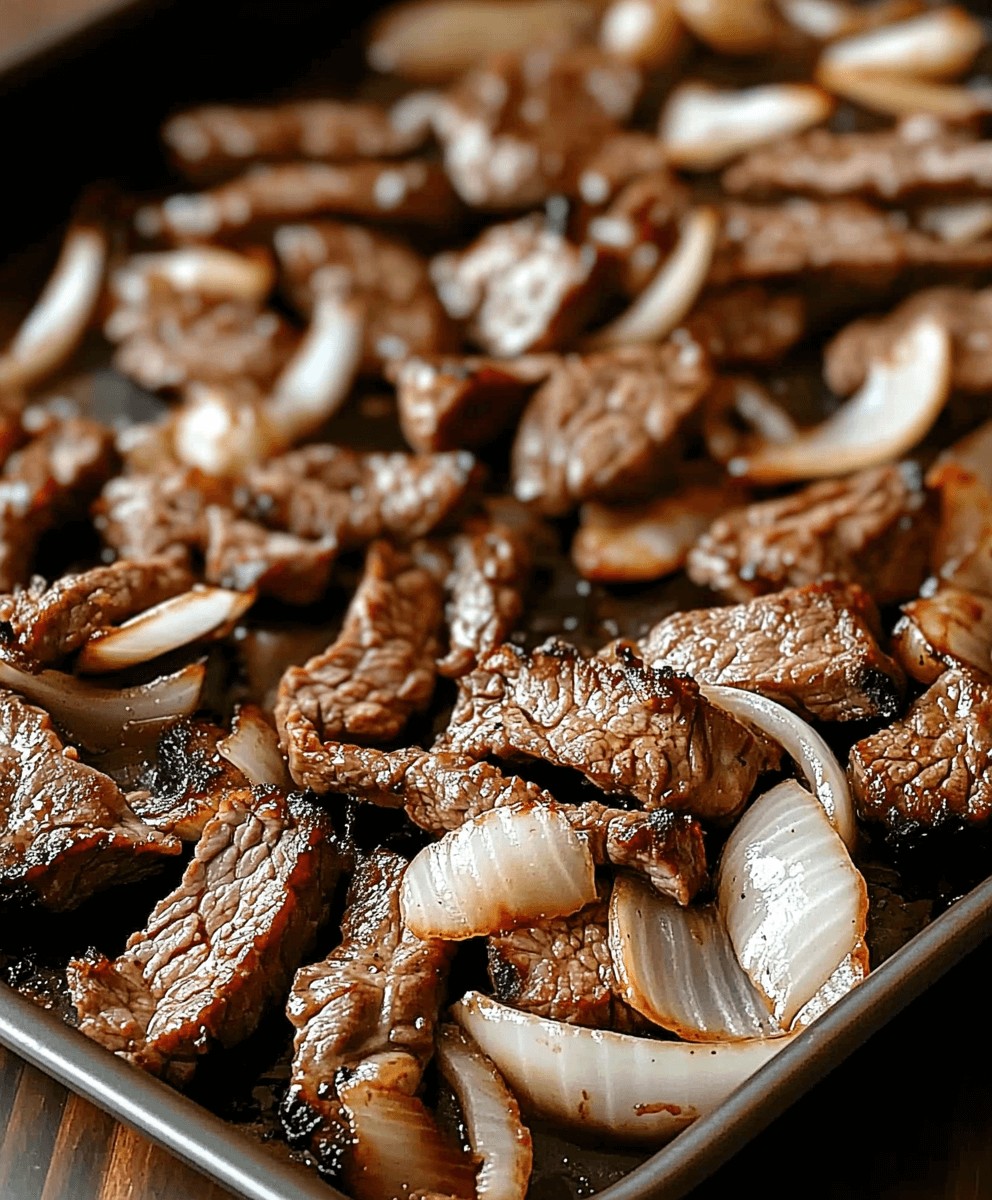 Pin it
Pin it
This sheet pan Korean beef bulgogi transforms thin slices of sirloin into a caramelized, flavor-packed dinner with minimal effort. The sweet and savory marinade gives that authentic Korean BBQ flavor but lets your oven do all the work for a delicious weeknight meal.
I discovered this recipe during a particularly busy season when I needed quick dinners that still felt special. My family now requests it almost weekly, and the aroma of the marinade instantly brings everyone to the kitchen.
Ingredients
- Beef sirloin: Thinly sliced for quick cooking and maximum flavor absorption
- Soy sauce: Creates the umami base of the marinade
- Brown sugar: Caramelizes beautifully and balances the savory elements
- Gochujang: Adds authentic Korean heat and depth that regular hot sauce cannot match
- Sesame oil: Provides that distinctive nutty aroma essential to Korean cuisine
- Fresh ginger and garlic: Form the aromatic foundation
- Snap peas: Add crispness and vibrant color that withstands high heat roasting
- Scallions: Provide a fresh finish and traditional garnish
Step-by-Step Instructions
- Prepare the marinade:
- Combine soy sauce, brown sugar, Worcestershire sauce, minced ginger, garlic, gochujang, and sesame oil in a bowl and whisk thoroughly until the sugar dissolves completely. This balanced blend creates the signature sweet savory profile of classic bulgogi.
- Marinate the beef:
- Add your thinly sliced sirloin to the marinade, ensuring each piece gets fully coated. Allow to marinate for at least one hour in the refrigerator. The longer the better for flavor development, up to overnight if you have time.
- Prepare the vegetables:
- Preheat your oven to 450°F. Place your sliced onions and trimmed snap peas on a large sheet pan and toss with olive oil. Season generously with salt and freshly ground black pepper to enhance their natural flavors.
- Arrange the beef:
- Remove the beef from the marinade, allowing excess to drip off. Arrange the slices in a single layer on the sheet pan alongside the vegetables. Ensure pieces aren't overlapping for even cooking and proper caramelization.
- Roast to perfection:
- Place the sheet pan in the oven and roast for exactly 10 minutes. The high heat will create delicious charred edges on the beef while keeping the center tender and juicy. The vegetables will soften while maintaining some pleasant texture.
- Finish and serve:
- Remove from the oven and immediately toss with freshly sliced scallions. The residual heat will slightly wilt them while preserving their fresh flavor. Serve immediately over steamed white rice for an authentic experience.
Gochujang is truly the secret weapon in this recipe. The first time I made this, I substituted regular hot sauce and while good, it lacked the depth and complexity. When I finally found gochujang at my local Asian market, the difference was remarkable. My daughter, who typically avoids spicy foods, actually asked for seconds because the flavor is so much more than just heat.
Make-Ahead Options
This dish works wonderfully for meal prep. You can prepare the marinade and slice the beef up to two days before cooking. Store separately in airtight containers in the refrigerator. The vegetables can be prepped the day before, though I recommend tossing them with oil and seasoning just before cooking for optimal freshness.
Ingredient Substitutions
While authentic bulgogi calls for specific cuts like rib eye, sirloin provides an excellent balance of flavor and tenderness at a more accessible price point. If beef is not your preference, this marinade works beautifully with thinly sliced pork tenderloin or even chicken thighs, though cooking times may need slight adjustment. For a vegetarian version, firm tofu or portobello mushrooms absorb the flavors wonderfully but require a longer marinating time.
Serving Suggestions
Beyond the traditional white rice, this bulgogi pairs beautifully with Korean side dishes like kimchi or quick pickled vegetables for a contrasting tang. For a lower carb option, serve over cauliflower rice or wrapped in butter lettuce leaves. My family enjoys setting up a DIY bulgogi bowl bar with various toppings like sliced avocado, shredded carrots, and sesame seeds so everyone can customize their meal.
The Cultural Context
Bulgogi, meaning "fire meat" in Korean, traditionally involves grilling thinly sliced marinated beef over an open flame. This sheet pan adaptation maintains the signature flavors while making it accessible for home cooks without specialized equipment. The dish dates back centuries in Korean cuisine and has evolved from being reserved for special occasions to becoming a beloved everyday meal, both in Korea and internationally.
Frequently Asked Questions
- → Can I use a different cut of beef?
Yes, you can substitute sirloin with flank steak, ribeye, or even tenderloin. Just ensure it’s sliced thinly for best results.
- → Is gochujang necessary?
Gochujang adds authentic Korean flavor, but you can replace it with chili garlic sauce or omit it if you prefer less heat.
- → Can I use other vegetables?
Absolutely! Bell peppers, broccoli, or zucchini can be great alternatives or additions to snap peas and onions.
- → What’s the best way to slice beef thinly?
Partially freeze the beef for about 20-30 minutes before slicing. This firms it up and makes thin slices easier to achieve.
- → How can I make this meal ahead of time?
Marinate the beef up to 24 hours in advance and pre-slice the veggies. When ready, assemble and roast everything on the day of serving.
